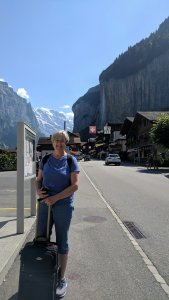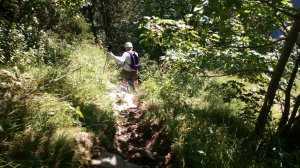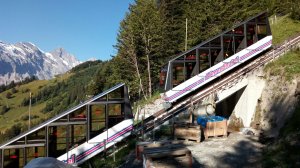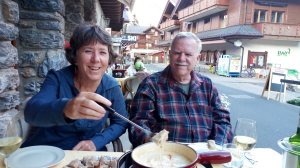
“The Ogre, the Monk, and the Virgin”. That’s the popular English translation of the “Eiger, Monch, and Jungfrau”, the names of three mountains in the Swiss Alps. (Did you think I was talking about the people in the photo? Nooo.)
Dennis & Becky joined me in Switzerland for three days that coincided with my birthday in the middle of summer and it was wonderful to spend time with them in this spectacular place. We lodged in the picturesque ski village of Murren, perched halfway up the side of the mountain in the Jungfrau region.
From our hotel deck, we looked across the deep, narrow Lauterbrunnen valley to the three mountains, looming so large that it seemed an illusion.
We lost count of the waterfalls that plunge from the mountainsides to the valley below, and we watched the brightly colored parasails float gently down and then rise up on the mountain drafts. The beauty is beyond description, so I will let some photos do the talking.





The legend of the ogre, the monk, and the virgin is likely the product of modern-day tourism. “Jungfrau” does in fact translate to “young girl” or “virgin”, and the name probably originates from the valley below the mountain where there were cattle pastures, which were commonly referred to as “Jungfrauenberge”, after the nearby convents that had dairy pastures. But the legend that an ogre tried to reach the virgin, and a monk interceded between to protect the virgin is far more colorful than the true name origins. “Monch” is probably a shortened “munchenberg”, which is the meadow below the mountain where the gelding horses (munche) were pastured. “Ogre”, as a cruel & hideous creature, is the child of a lazy translation from German to English. “Eiger” comes from middle high German, meaning “high peak”, and the Swiss vernacular “hoger”.
But the true stories of danger and rescue on these mountains are spellbinding. All three peaks were alluring to climbers during the infancy of the sport of mountaineering. In the early 20th century, there was an atmosphere of competition to bag “first ascents” and the north face of the Eiger, thought to be unclimbable, had a siren call to mountaineeers. While we sipped coffee from the comfort of a cafe facing the mist-shrouded Eiger, Dennis recounted the tragic true story of a 1936 expedition on the infamous North Face of the Eiger. I’ve paraphrased the story as told in “The White Spider” by Heinrich Harrer, below:
A team of four experienced climbers, 2 Austrians and 2 Bavarians, was one of the parties that had eyes on a first ascent in the summer of 1936. Twenty-three year old Toni Kurz was a member of this team that began their attempt in mid-July. Public interest in this dare-devil sport was high, and in the villages below news reporters and spectators monitored the progress through binoculars and telescopes.
The team’s rapid progress on the the first day was hailed by the watchers in the valley. But when the team made a stop, and then two of the men trailed behind at a slower rate, the observers speculated that one of the men had become injured. On the second day, the team continued to forge a route up the mountain with the injured man moving more slowly than the others. But on day three the group reversed course and the spectators watched from afar as the climbers began their descent.
The Eiger was not a pristine mountain. In 1896, man violated nature by commencing to blast a railway tunnel through the mountain. In 1912, the railway to the “Top of Europe”, terminating on the Jungfrau saddle, was completed. This tourist attraction took passengers on a cog-wheel train that travels through 7 kilometers of tunnels inside the Eiger mountain. At 2 locations inside the tunnel, stations were established and large panoramic “windows” were cut out of the mountain and opened to the sky on the vertical wall of the North Face.
On the afternoon of the fourth day of the climb, the rail station guard speculated that the climbers were somewhere above his window on the face of the mountain. Not expecting a reply, he called up into the misty void above the window. When four cheery voices floated down from above with the report that “all is well” and they would be down soon, he was surprised and pleased.
Two hours passed and the climbers had not arrived. When the station guard called up from his window again, the world shifted. A desperate lone voice replied. “Help! I am the only one alive! The other three are dead!”
Toni Kurz was hanging on the rope in a sling, unable to descend any further. Rescuers rushed to the mountain and climbed as close as they could, but were still 300 yards below the lone survivor. A storm was moving in and as night fell the rescuers were forced to retreat, haunted by the sound of Toni’s desperate pleas.
Toni survived the night, but his left hand and arm had become frozen and unusable. In the morning the rescuers attempted every approach, but still they could not reach him. With ingenuity and unimaginable grit, Toni and the rescuers managed to get him another 120 feet down the face. But now, a knot in the rope jammed in a snap-link as his rope passed over a jutting ledge, and he dangled in mid-air, exhausted and just beyond the reach of his rescuers.
Words of encouragement were the only thing that could reach across the small gap between Toni and safety. But they could not sustain him. The rescuers heard Toni’s mumbled final words, and watched impotently as life faded, and then was gone, from the body that swung in mid-air over the abyss.
Dennis himself answered the mountains’ siren call on this trip by climbing a traverse of the Via Ferrata. It was advertised as a daring, yet technically safe, adventure walking across a skinny suspension bridge strung over a deep Alpine canyon. Becky and I volunteered to watch from terra firma above the cliff face. With a helmet and hardware rented from a local mountaineering shop, he assured us that he did not require a guide. He had climbed many mountains in his youth, including the vertical walls of Yosemite valley. The shopkeeper told Becky and me to expect his return in about three hours, and a few minutes later we said ‘goodbye’ as we watched him agily clamber down the cable at the start of the route.


Two and a half hours later Becky received a text message. Dennis had finished the route and would meet us back in the village! When we saw him, he was sweaty and his palms were blistered, but he smiled and in his understated manner said “that was cool!” He moved slowly. His legs, arms, and hands were exhausted from climbing and gripping. The route included climbing vertically down a series of steel rungs anchored into the cliff face. I was pleased with my decision to stand watch at the cafe while he climbed.


A trip to the Swiss Alps is not for wimps. You’ve got to really want it. You must have stamina and agility. And I’m not talking about scaling the impossibly steep mountains that stretch to the heavens. I’m talking about logistics. I needed two buses, a plane, five trains, and a cable-car to go from Seville, Spain to the hotel in Murren, Switzerland. (Dennis & Becky had the additional complication of standby flights from Denver and JFK.) This bore no resemblance to my typical U.S. travels: get in the car and drive until you get there. Like I said, it takes stamina and agility.



I am glad that it is not easy or inexpensive to visit the Alps. The obstacles help ensure that a trip to Jungfrau is rare and special, not commonplace or routine. I feel that my visit to this spectacular landscape, just a few steps from heaven’s door, is a privilege, and I am grateful.
And I would do it again in a heartbeat.





DianneStunning photography….all good for your eventual book on your travels this year!!!!!Cheers Judy
LikeLike
Thanks Judy. It’s easy to take good photos when the scenery is so beautiful!
LikeLike
Hello Dianne- Great travel essay on your journey to the Jung Frau and Lauterbrunnen. I sprained my ankle in Lauterbrunen and the only ice I could get for it was frozen vegetables from a grocery store. Did you go to the Top of Europe building at JungFRaujoch?….the most spectacular glacier views….I am glad you are having a good trip….be well. -Mike
LikeLike
Hi Mike. Lauterbrunnen is a beautiful village! I didn’t make it to Top of Europe because it was cloudy and rainy up top. I guess that means I have to go back….
LikeLike
This all looks so amazing. I wish I could have joined. You look so happy in all of your pictures. Traveling must agree with you. See you soon
LikeLike